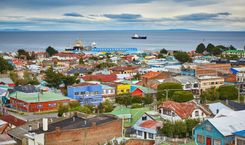"There is not a person in sight"
Our view ahead is temporarily blurred as billowing clouds of dust fill the sky, the result of Chilean army tank exercises, my guide, Jaime, explains. Then, some 45km inland from Iquique, a strange sight appears ahead: in the middle of the desert plain sits the giant rusty skeleton of what looks like a marooned ship.
Slowly other structures materialise: a set of train tracks, clusters of huts and warehouses, and finally neat rows of houses and dusty streets. There is not a person in sight.
This ghost town, Santa Laura, is one of the remnants of a largely forgotten industry that once made the Atacama Desert one of the most valuable places in the world. In the nineteenth century, the vast saltpetre (potassium nitrate) deposits in the region – then part of Peru and Bolivia – were heavily in demand for use as fertiliser and gunpowder in Europe and North America.
Becoming a UNESCO World Heritage Site
A booming industry developed, with rapacious nitrate barons – many of them British – using the hefty profits to build opulent mansions in cities like Iquique. In 1878 the War of the Pacific broke out between Chile, Peru and Bolivia: five years later, Chile emerged victorious, having seized all of the nitrate territories.
Of the 200 or so oficinas salitreras (saltpetre works) that operated during the industry’s heyday, only one – María Elena – still operates. The rest have disappeared, stripped clean of anything valuable and eventually swallowed by the desert after World War One signalled the beginning of the end of the nitrate boom. But for a quirk of fate, Santa Laura and neighbouring Humberstone would have suffered the same.
“After the mines were abandoned in the 1960s they were occupied by homeless people. There was rubbish everywhere, graffiti, the mummified bodies of dead dogs,” says Jaime. “Santa Laura and Humberstone were then bought by a businessman who planned to sell off the remains for scrap. But he went bankrupt first, which actually preserved it. They were taken over by a non-profit organisation, cleaned up and made UNESCO World Heritage Sites in 2005.”









